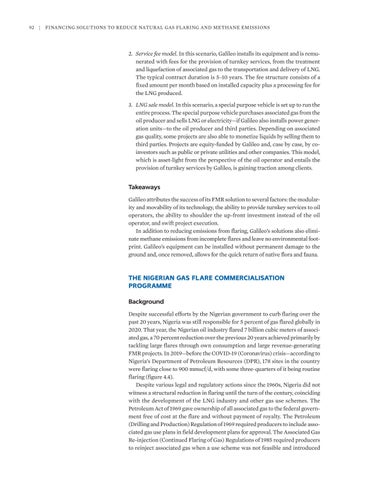92
| Financing Solutions to Reduce Natural Gas Flaring and Methane Emissions
2. Service fee model. In this scenario, Galileo installs its equipment and is remunerated with fees for the provision of turnkey services, from the treatment and liquefaction of associated gas to the transportation and delivery of LNG. The typical contract duration is 5–10 years. The fee structure consists of a fixed amount per month based on installed capacity plus a processing fee for the LNG produced. 3. LNG sale model. In this scenario, a special purpose vehicle is set up to run the entire process. The special purpose vehicle purchases associated gas from the oil producer and sells LNG or electricity—if Galileo also installs power generation units—to the oil producer and third parties. Depending on associated gas quality, some projects are also able to monetize liquids by selling them to third parties. Projects are equity-funded by Galileo and, case by case, by co- investors such as public or private utilities and other companies. This model, which is asset-light from the perspective of the oil operator and entails the provision of turnkey services by Galileo, is gaining traction among clients.
Takeaways Galileo attributes the success of its FMR solution to several factors: the modularity and movability of its technology, the ability to provide turnkey services to oil operators, the ability to shoulder the up-front investment instead of the oil operator, and swift project execution. In addition to reducing emissions from flaring, Galileo’s solutions also eliminate methane emissions from incomplete flares and leave no environmental footprint. Galileo’s equipment can be installed without permanent damage to the ground and, once removed, allows for the quick return of native flora and fauna.
THE NIGERIAN GAS FLARE COMMERCIALISATION PROGRAMME Background Despite successful efforts by the Nigerian government to curb flaring over the past 20 years, Nigeria was still responsible for 5 percent of gas flared globally in 2020. That year, the Nigerian oil industry flared 7 billion cubic meters of associated gas, a 70 percent reduction over the previous 20 years achieved primarily by tackling large flares through own consumption and large revenue-generating FMR projects. In 2019—before the COVID-19 (Coronavirus) crisis—according to Nigeria’s Department of Petroleum Resources (DPR), 178 sites in the country were flaring close to 900 mmscf/d, with some three-quarters of it being routine flaring (figure 4.4). Despite various legal and regulatory actions since the 1960s, Nigeria did not witness a structural reduction in flaring until the turn of the century, coinciding with the development of the LNG industry and other gas use schemes. The Petroleum Act of 1969 gave ownership of all associated gas to the federal government free of cost at the flare and without payment of royalty. The Petroleum (Drilling and Production) Regulation of 1969 required producers to include associated gas use plans in field development plans for approval. The Associated Gas Re-injection (Continued Flaring of Gas) Regulations of 1985 required producers to reinject associated gas when a use scheme was not feasible and introduced


